What sand is needed for the foundation
Before you begin construction work, many first calculate everything and procure material. This is correct and commendable. But at this stage different questions arise, one of which is what sand is needed for the foundation. Selection of sand should be given special attention, as it is one of the main and important components used in the mixing of concrete. And your future foundation, foundation depends on the quality of the concrete mix. Taking into account the fact that the market has a large selection of different sand, both natural and artificially produced, it is important to choose the most suitable one for these jobs. In this article we will describe how to make a choice.
Purely theoretical
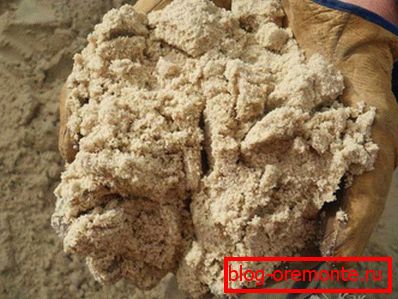
Any person who is not well versed in the construction business and its nuances can guess that it is necessary to choose clean sand for the foundation. Initially, different organic elements may be present in the sand, such as grass, branches, and so on. Such sand is not suitable for work, but it can be easily cleaned. Maybe you have often seen workers sifting sand, cleaning it of unwanted elements.
But if we talk about such impurities as clay, lime and other similar ones, then there is no way to do it by simple sifting. It is more difficult to clean this sand, so when buying, you need to immediately pay attention to it. The presence of clay in the sand should not exceed 5% of the total mass, especially if we talk about the base solution. Otherwise, the future structure of reliability will not differ, it will shrink, and this will lead to cracks. Before buying it is important to check how clean the sand is. For verification, you can use the simple method.
You will need a clear bottle, either glass or plastic. In it you need to fill the sand to 1/3 and fill with water to half. Next, shake the bottle vigorously so that the sand mixes with water and becomes completely wet. After that, put it and wait 5-10 minutes. If the water has become dirty, this sand will not be suitable for the foundation. If a foreign substance has formed on the surface, with a layer of more than 5 mm, such sand cannot be taken. Let's look at what types of sand are, how they differ and what kind of sand is better to acquire for the foundation.
Varieties of sand

Sand is divided into several types, depending on the place of its production:
- River.
- Nautical.
- Career.
The name of the river sand itself says that it is mined from the bottom of the river. This is a versatile material, as it contains fractions of different sizes - from 1.6 mm to 2.2 mm. Because of this, it is used not only to fill the foundation, but also for various construction purposes. To call the main advantage of river sand can be its natural purity and uniformity. Clay, particles of vegetation and other impurities in it are very small. This sand is ideal for foundations. Only here its price is high enough.

Sea sand is extracted from the bottom of the sea, after which it is cleaned of shell rock and other impurities. The difference of this sand is its grain, which is about 1 mm. Such a size of granules allows its use for the construction of reinforced concrete structures. It can be called clean enough, as it is cleaned, screened and washed before being sold. But you have to pay for quality, so sea sand is the most expensive.
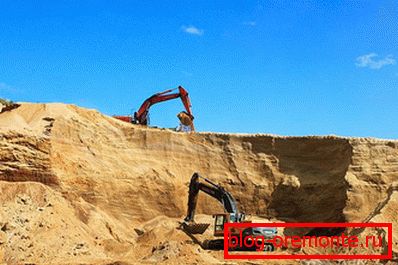
Career sand is mined in an open way from the quarry. If you compare it with the river and sea sands - this is the worst option. And it is not surprising, since there are a lot of impurities in its composition - clay, vegetation and crushed stone. Because of this, the price of such sand is the lowest and is suitable for roughing work at the initial stage of construction.
To uniquely determine which sand is best suited for concrete, it is important to consider other features. Some masters advise to buy career sand, which is cheaper, referring to the fact that it will not affect the quality of the base of the house. Others say that the quality is above the price, so you need to choose expensive sand, which will ensure the reliability of the foundation on which you can not save. Anyway, it is necessary to consider other features and criteria that will help determine the choice.
Specifications
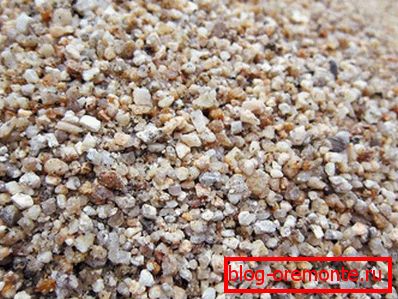
As stated above, the sand must be clean. If it has vegetation or branches - it is not scary, they can be weeded out. But clay, silt, gravel and other particles can lead to a decrease in the quality of the concrete solution. The presence of clay should not exceed 5%. The presence of gravel as a percentage of the total mass should not be more than 5%, and the size of particles - more than 10–12 mm. If the size of gravel ranges from 5 mm to 10 mm, then a larger percentage is allowed - up to 10% of the total mass.
An important moment when choosing a material is its particle size distribution, that is, the size of the granules. Based on the size of the sand granules, it is divided into:
- very fine sand, the size of the granules is not more than 0.7 mm. Such sand would be unsuitable for making concrete;
- fine sand, grain size is from 0.7 mm to 1 mm. This view is also not used for the manufacture of concrete;
- very fine sand, the size of the granules is in the range from 1 mm to 1.5 mm. It is also not necessary to choose it for concrete;
- fine sand, the size of the granules from 1.5 mm to 2 mm. Not suitable for the preparation of high-quality concrete mix;
- medium sand, granule size from 2 mm to 2.5 mm. It is sand of this size that is ideal for preparing a concrete mix under the foundation;
- coarse sand, the size of the granules is from 2.5 mm to 3 mm. It is used for the manufacture of high-quality concrete;
- sand of increased size, the size of the granules is from 3 mm to 3.5 mm. It is better to use sand of such fraction for a pillow of the base under the construction basis.
Very coarse sand with a size of more than 3.5 mm can also be used as a foundation cushion.
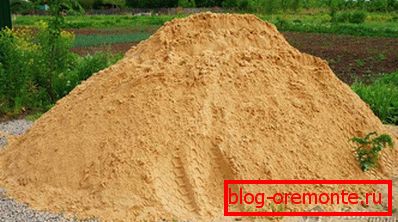
Another important point when choosing sand for the foundation is humidity. The water content in the sand plays an important role, since its amount must be taken into account when the solution is mixed with the addition of water. The recommended moisture content of sand for the foundation should be no more than 5%. Dried rock can have 1% moisture. If the sand came under precipitation, then its humidity can reach up to 10%.
If you purchased sand, you need to take care of its protection from precipitation. To do this, you need something to cover or unload under a canopy. Then it will not absorb excess water.
But how to determine the humidity of the sand? Use the pan or iron bucket. Take the container and put it on the weight. Having learned the weight of the container, take 1 kg of sand and fill it with a container. Now you need to dry the sand. To do this, put it on the stove with low fire and "cook", stirring for 30 minutes. After the time, everything must be weighed again. From the weighing result, subtract the weight of the bowl or bucket and multiply the result by 100. As a result, you should get a number in percentage, which indicates humidity. For clarity, a bucket or bowl weighs 0.2 kg. After you dried 1 kg of sand, the total weight was 0.9 kg. It turns out:
0.9 - 0.2 x 100 = 70
The moisture content of your sand is 7%. There is another method for determining humidity. Simply use a special device that shows the exact figure.
Let's sum up
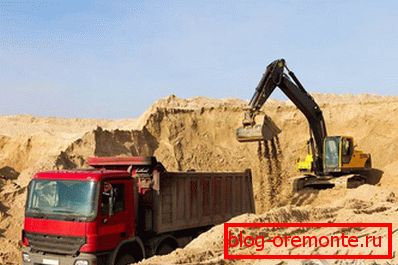
So, having all the data, you need to analyze them and make a choice. You have learned that the ideal sand for the foundation is:
- clean sand, in which clay and gravel do not exceed 5% of the total mass;
- sand with medium size, the size of the granules is from 2 mm to 2.5 mm;
- sand, the humidity of which does not exceed 5%.
When buying such building materials for the foundation, you must pay attention to these indicators. The best option for the price and quality is washed and screened career sand, granule size of 2-2.5 mm. It is better to buy it directly in the place of mining. If you have money and want your foundation to be solid and stand for a very long time, stop at the river sand of the same faction. Then your concrete under the foundation will have the necessary qualities.
When buying sand, it is necessary to control the process of weighing the loaded and empty dump truck, as there are unscrupulous suppliers who do not weigh the sand, profiting from you.
We hope that this article has helped you figure out what kind of sand to choose for the foundation.
See also:
- how to fill the strip foundation;
- selection of cement for the foundation;
- how to make a tape foundation with your own hands;
- manufacture of formwork for the foundation.
Video
Sand selection tips below: